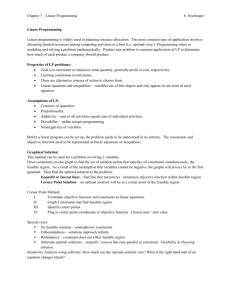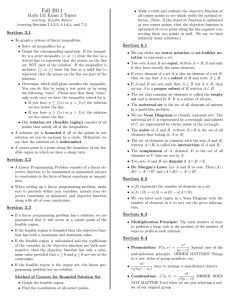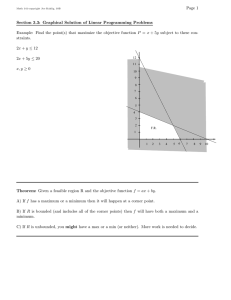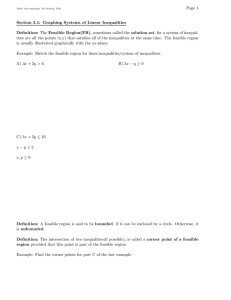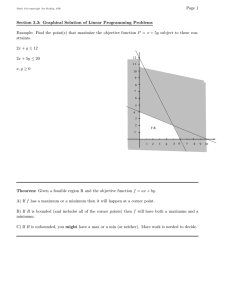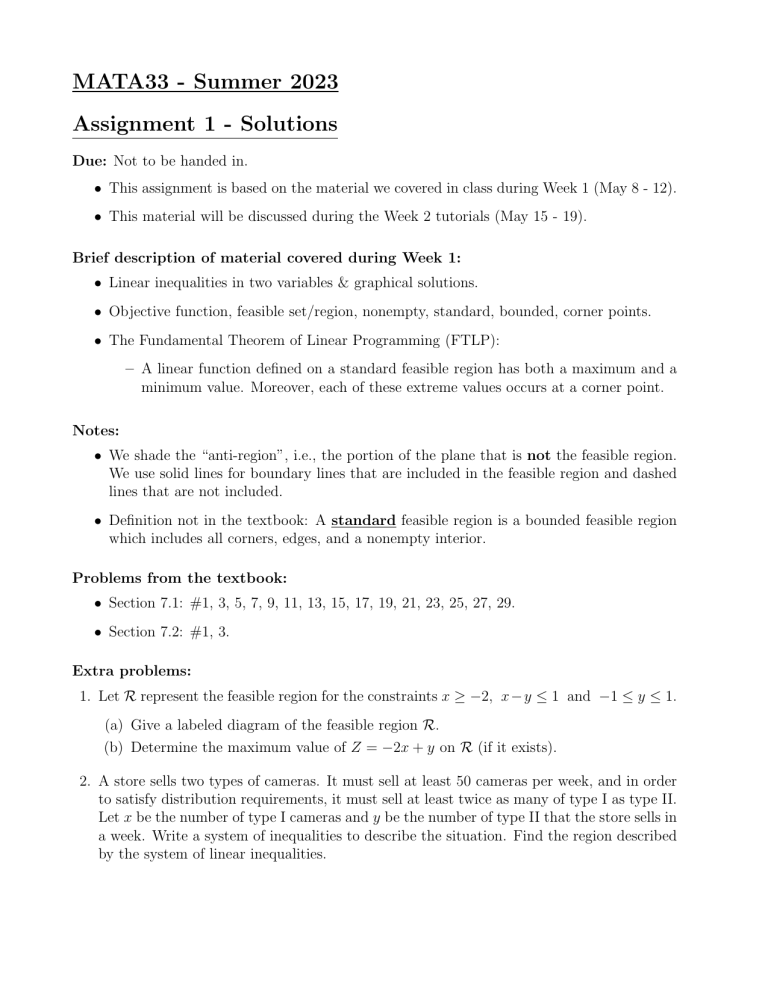
MATA33 - Summer 2023 Assignment 1 - Solutions Due: Not to be handed in. • This assignment is based on the material we covered in class during Week 1 (May 8 - 12). • This material will be discussed during the Week 2 tutorials (May 15 - 19). Brief description of material covered during Week 1: • Linear inequalities in two variables & graphical solutions. • Objective function, feasible set/region, nonempty, standard, bounded, corner points. • The Fundamental Theorem of Linear Programming (FTLP): – A linear function defined on a standard feasible region has both a maximum and a minimum value. Moreover, each of these extreme values occurs at a corner point. Notes: • We shade the “anti-region”, i.e., the portion of the plane that is not the feasible region. We use solid lines for boundary lines that are included in the feasible region and dashed lines that are not included. • Definition not in the textbook: A standard feasible region is a bounded feasible region which includes all corners, edges, and a nonempty interior. Problems from the textbook: • Section 7.1: #1, 3, 5, 7, 9, 11, 13, 15, 17, 19, 21, 23, 25, 27, 29. • Section 7.2: #1, 3. Extra problems: 1. Let R represent the feasible region for the constraints x ≥ −2, x − y ≤ 1 and −1 ≤ y ≤ 1. (a) Give a labeled diagram of the feasible region R. (b) Determine the maximum value of Z = −2x + y on R (if it exists). 2. A store sells two types of cameras. It must sell at least 50 cameras per week, and in order to satisfy distribution requirements, it must sell at least twice as many of type I as type II. Let x be the number of type I cameras and y be the number of type II that the store sells in a week. Write a system of inequalities to describe the situation. Find the region described by the system of linear inequalities. Solutions • Answers to all problems in Section 7.1 #1-29 (odd) are sketched in the back of the textbook. • Extra detail for Section 7.2 #1, 3 is provided below. Solution: Section 7.2: #1. The question asks to maximize P = 5x + 7y subject to 2x + 3y ≤ 45, x − 3y ≥ 2 and x, y ≥ 0. The lines 2x + 3y = 45 and x − 3y = 2 intersect at the point (47/3, 41/9). Shading the anti-region leaves an unshaded region that we denote by R: Since R is a bounded, standard region, by the Fundamental Theorem of Linear Programming, the linear function P = 5x + 7y will have both a maximum value and a minimum value on R. Furthermore, each of these extreme values occurs at a corner point. Thus, it suffices to test each corner point. • At (x, y) = (2, 0) we have P = 5(2) + 7(0) = 10. • At (x, y) = (45/2, 0) we have P = 5(45/2) + 7(0) = 225 2 = 112.5. • At (x, y) = (47/3, 41/9) we have P = 5(47/3) + 7(41/9) = 992 9 ≈ 110.22. Thus, the maximum value of P = 5x + 7y on R is P = 112.5 occurring at (x, y) = (45/2, 0). Page 2 Solution: Section 7.2: #3. The question asks to maximize Z = 4x − 6y subject to y ≤ 7, 3x − y ≤ 3, x + y ≥ 5 and x, y ≥ 0. The lines 3x − y = 3 and x + y = 5 intersect at the point (2, 3). The lines y = 7 and 3x − y = 3 intersect at the point (10/3, 7). Shading the anti-region leaves an unshaded region that we denote by R: Since R is s bounded, standard region, by the Fundamental Theorem of Linear Programming, the linear function Z = 4x − 6y will have both a maximum value and a minimum value on R. Furthermore, each of these extreme values occurs at a corner point. Thus, it suffices to test each corner point. • At (x, y) = (0, 5) we have Z = 4(0) − 6(5) = −30. • At (x, y) = (0, 7) we have Z = 4(0) − 6(7) = −42. • At (x, y) = (10/3, 7) we have Z = 4(10/3) − 6(7) = −86/3 ≈ −28.67. • At (x, y) = (2, 3) we have Z = 4(2) − 6(3) = −10. Thus, the maximum value of Z = 4x − 6y on R is Z = −10 occurring at (x, y) = (2, 3). Page 3 Extra problems: 1. Let R represent the feasible region for the constraints x ≥ −2, x − y ≤ 1 and −1 ≤ y ≤ 1. (a) Give a labeled diagram of the feasible region R. (b) Determine the maximum value of Z = −2x + y on R (if it exists). Solution: (a) We first sketch x = −2, y = x − 1, y = −1 and y = 1. Since equality is included, we have solid lines bounding the region R. Shading the anti-region gives: (b) Since R is a bounded, standard, by the Fundamental Theorem of Linear Programming, the linear function Z = −2x + y will have both a maximum value and a minimum value on R. Furthermore, each of these extreme values occurs at a corner point. Thus, it suffices to test each corner point. • At (x, y) = (−2, 1) we have Z = −2(−2) + 1 = 5. • At (x, y) = (2, 1) we have Z = −2(2) + 1 = −3. • At (x, y) = (0, −1) we have Z = −2(0) − 1 = −1. • At (x, y) = (−2, −1) we have Z = −2(−2) − 1 = 3. Thus, the maximum value of Z = −2x + y on R is Z = 5 occurring at (x, y) = (−2, 1). Page 4 2. A store sells two types of cameras. It must sell at least 50 cameras per week, and in order to satisfy distribution requirements, it must sell at least twice as many of type I as type II. Let x be the number of type I cameras and y be the number of type II that the store sells in a week. Write a system of inequalities to describe the situation. Find the region described by the system of linear inequalities. Solution: Since negative numbers of cameras cannot be sold, x ≥ 0 and y ≥ 0 . Selling at least 50 cameras per week corresponds to x + y ≥ 50. Selling twice as many of type I as of type II corresponds to x ≥ 2y. The system of inequalities is x + y ≥ 50 x ≥ 2y x≥0 y≥0 The region consists of points on or above the x-axis and on or to the right of the y-axis. In addition, the points must be on or above the line x + y = 50 and on or below the line x = 2y. Shading the anti-region gives: Page 5
